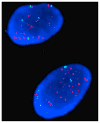Expression of epidermal growth factor variant III (EGFRvIII) in pediatric diffuse intrinsic pontine gliomas
- PMID: 22382786
- PMCID: PMC3368992
- DOI: 10.1007/s11060-012-0842-3
Expression of epidermal growth factor variant III (EGFRvIII) in pediatric diffuse intrinsic pontine gliomas
Abstract
Despite numerous clinical trials over the past 2 decades, the overall survival for children diagnosed with diffuse intrinsic pontine glioma (DIPG) remains 9-10 months. Radiation therapy is the only treatment with proven effect and novel therapies are needed. Epidermal growth factor receptor variant III (EGFRvIII) is the most common variant of the epidermal growth factor receptor and is expressed in many tumor types but is rarely found in normal tissue. A peptide vaccine targeting EGFRvIII is currently undergoing investigation in phase 3 clinical trials for the treatment of newly diagnosed glioblastoma (GBM), the tumor in which this variant receptor was first discovered. In this study, we evaluated EGFRvIII expression in pediatric DIPG samples using immunohistochemistry with a double affinity purified antibody raised against the EGFRvIII peptide. Staining of pediatric DIPG histological samples revealed expression in 4 of 9 cases and the pattern of staining was consistent with what has been seen in EGFRvIII transfected cells as well as GBMs from adult trials. In addition, analysis of tumor samples collected immediately post mortem and of DIPG cells in culture by RT-PCR, western blot analysis, and flow cytometry confirmed EGFRvIII expression. We were therefore able to detect EGFRvIII expression in 6 of 11 DIPG cases. These data suggest that EGFRvIII warrants investigation as a target for these deadly pediatric tumors.
Conflict of interest statement
Figures





References
-
- Central brain tumor registry of the United States. 2009.
-
- Freeman CR, Farmer JP. Pediatric brain stem gliomas: a review. Int J Radiat Oncol Biol Phys. 1998;40(2):265. - PubMed
-
- Recinos PF, Sciubba DM, Jallo GI. Brainstem tumors: where are we today? Pediatr Neurosurg. 2007;43(3):192. - PubMed
-
- Bernier-Chastagner V, et al. Topotecan as a radiosensitizer in the treatment of children with malignant diffuse brainstem gliomas: results of a French Society of Paediatric Oncology Phase II Study. Cancer. 2005;104(12):2792. - PubMed
-
- Korones DN, et al. Treatment of children with diffuse intrinsic brain stem glioma with radiotherapy, vincristine and oral VP-16: a Children’s Oncology Group phase II study. Pediatr Blood Cancer. 2008;50(2):227. - PubMed
MeSH terms
Substances
Grants and funding
LinkOut - more resources
Full Text Sources
Research Materials
Miscellaneous

